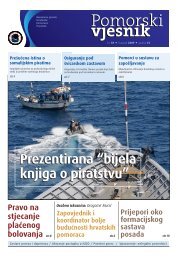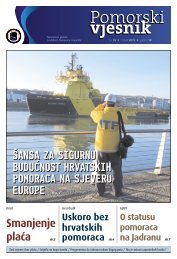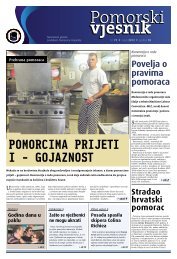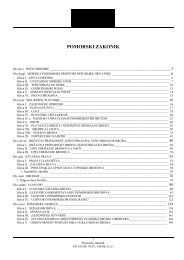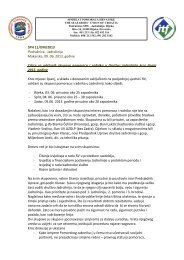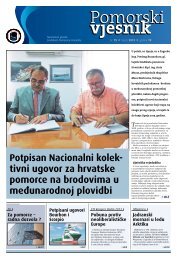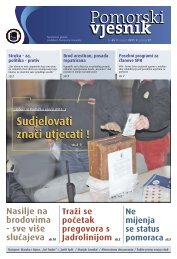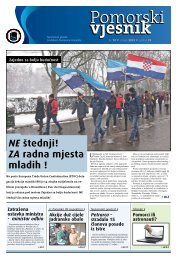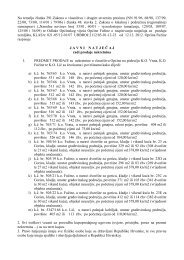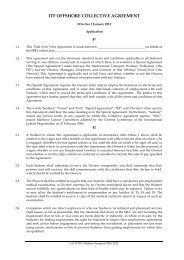Konvencija o radu pomoraca, 2006 (engleski i hrvatski jezik)
Konvencija o radu pomoraca, 2006 (engleski i hrvatski jezik)
Konvencija o radu pomoraca, 2006 (engleski i hrvatski jezik)
You also want an ePaper? Increase the reach of your titles
YUMPU automatically turns print PDFs into web optimized ePapers that Google loves.
(b) facilitate easy cleaning and disinfection to prevent or control the spread of disease.<br />
3. Power for the operation of the air conditioning and other aids to ventilation required by the preceding<br />
paragraphs of this Guideline should be available at all times when seafarers are living or working<br />
on board and conditions so require. However, this power need not be provided from an emergency<br />
source.<br />
Guideline B3.1.3 - Heating<br />
1. The system of heating the seafarer accommodation should be in operation at all times when seafarers<br />
are living or working on board and conditions require its use.<br />
2. In all ships in which a heating system is required, the heating should be by means of hot water,<br />
warm air, electricity, steam or equivalent. However, within the accommodation area, steam should not<br />
be used as a medium for heat transmission. The heating system should be capable of maintaining the<br />
temperature in seafarer accommodation at a satisfactory level under normal conditions of weather and<br />
climate likely to be met within the trade in which the ship is engaged. The competent authority should<br />
prescribe the standard to be provided.<br />
3. Radiators and other heating apparatus should be placed and, where necessary, shielded so as to avoid<br />
risk of fire or danger or discomfort to the occupants.<br />
Guideline B3.1.4 - Lighting<br />
1. In all ships, electric light should be provided in the seafarer accommodation. If there are not two<br />
independent sources of electricity for lighting, additional lighting should be provided by properly<br />
constructed lamps or lighting apparatus for emergency use.<br />
2. In sleeping rooms an electric reading lamp should be installed at the head of each berth.<br />
3. Suitable standards of natural and artificial lighting should be fixed by the competent authority.<br />
Guideline B3.1.5 - Sleeping rooms<br />
1. There should be adequate berth arrangements on board, making it as comfortable as possible for the<br />
seafarer and any partner who may accompany the seafarer.<br />
2. Where the size of the ship, the activity in which it is to be engaged and its layout make it reasonable<br />
and practicable, sleeping rooms should be planned and equipped with a private bathroom, including a<br />
toilet, so as to provide reasonable comfort for the occupants and to facilitate tidiness.<br />
3. As far as practicable, sleeping rooms of seafarers should be so arranged that watches are separated<br />
and that no seafarers working during the day share a room with watchkeepers.<br />
4. In the case of seafarers performing the duty of petty officers there should be no more than two persons<br />
per sleeping room.<br />
5. Consideration should be given to extending the facility referred to in Standard A3.1, paragraph 9(m),<br />
to the second engineer officer when practicable.<br />
6. Space occupied by berths and lockers, chests of drawers and seats should be included in the<br />
measurement of the floor area. Small or irregularly shaped spaces which do not add effectively to the<br />
space available for free movement and cannot be used for installing furniture should be excluded.<br />
161



